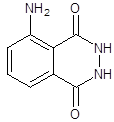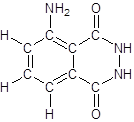
Concept explainers
Interpretation:
The chemical formula and percent composition of luminol needs to be determined.
Concept introduction:
The chemical composition of a substance is expressed by its chemical formula, which uses atomic
The composition of a substance represented in terms of percentage of each element in comparison to the total mass of the compound is said to be percent composition.
Answer to Problem 214A
The chemical formula of luminol is
Explanation of Solution
The structure of luminol is:

This structure can be rewritten as a complete structure as:

In order to determine the chemical formula, the number of atoms of each element in the compound is calculated as:
Thus, the chemical formula of luminol is
The molar mass is sum of the
Substituting the values:
Now, the percent composition is determined using formula:
Since, in 1 mole of luminol there are 8 moles of C, 7 moles of H, 3 moles of N and 2 moles of O so, the composition of each element will be:
Chapter 10 Solutions
Chemistry: Matter and Change
Additional Science Textbook Solutions
Organic Chemistry
Organic Chemistry (9th Edition)
General Chemistry: Principles and Modern Applications (11th Edition)
Inorganic Chemistry
Chemistry: The Central Science (14th Edition)
General, Organic, and Biological Chemistry (3rd Edition)
 ChemistryChemistryISBN:9781305957404Author:Steven S. Zumdahl, Susan A. Zumdahl, Donald J. DeCostePublisher:Cengage Learning
ChemistryChemistryISBN:9781305957404Author:Steven S. Zumdahl, Susan A. Zumdahl, Donald J. DeCostePublisher:Cengage Learning ChemistryChemistryISBN:9781259911156Author:Raymond Chang Dr., Jason Overby ProfessorPublisher:McGraw-Hill Education
ChemistryChemistryISBN:9781259911156Author:Raymond Chang Dr., Jason Overby ProfessorPublisher:McGraw-Hill Education Principles of Instrumental AnalysisChemistryISBN:9781305577213Author:Douglas A. Skoog, F. James Holler, Stanley R. CrouchPublisher:Cengage Learning
Principles of Instrumental AnalysisChemistryISBN:9781305577213Author:Douglas A. Skoog, F. James Holler, Stanley R. CrouchPublisher:Cengage Learning Organic ChemistryChemistryISBN:9780078021558Author:Janice Gorzynski Smith Dr.Publisher:McGraw-Hill Education
Organic ChemistryChemistryISBN:9780078021558Author:Janice Gorzynski Smith Dr.Publisher:McGraw-Hill Education Chemistry: Principles and ReactionsChemistryISBN:9781305079373Author:William L. Masterton, Cecile N. HurleyPublisher:Cengage Learning
Chemistry: Principles and ReactionsChemistryISBN:9781305079373Author:William L. Masterton, Cecile N. HurleyPublisher:Cengage Learning Elementary Principles of Chemical Processes, Bind...ChemistryISBN:9781118431221Author:Richard M. Felder, Ronald W. Rousseau, Lisa G. BullardPublisher:WILEY
Elementary Principles of Chemical Processes, Bind...ChemistryISBN:9781118431221Author:Richard M. Felder, Ronald W. Rousseau, Lisa G. BullardPublisher:WILEY





